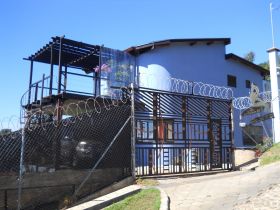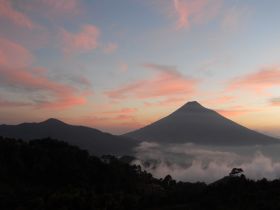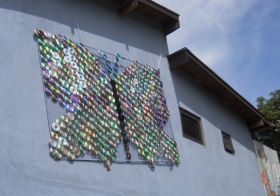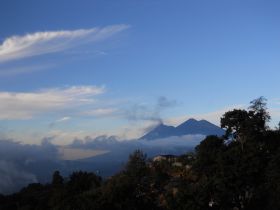HOW I CAME TO BUILD A HOUSE IN GUATEMALA -2-


I DO feel proud of building a house in Guatemala. I'm not going to get into the doing here, but lay the groundwork for WHY I did it. This is one of our views of the house and one of what we see out the windows.
First, why I came to Guatemala, then how the construction happened. Everyone asks, so here is the quick answer I’m tired of giving (because we have had many so guests in our bed and breakfast business who always ask). I came initially to study Spanish in Antigua and to paint watercolors, first for three weeks, then for three months. That time I was living in a Home Stay that provided a clean room, bathroom, and 3 meals a day. The young woman cleaning my room daily often expressed her desire to go back to school and finish because she loved learning and wanted to improve herself. She hoped to do a career program of two years in hotelerie and tourism. I had just retired and told her I would provide the expenses for her education in exchange for her to cook and clean for me. Meanwhile, another woman from California was living there as well, and she asked if we wanted to share in the rental of a large house with 4 or 5 bedrooms, along with some other extranjeros (strangers), as some call us. So it began.

Then this friend, Bonnie, announced she was planning to buy land and build a house in Guatemala. I went with her and a realtor a couple of times to look at land in the town of El Hato, four miles up a hill from Antigua. I couldn’t imagine why she wanted to do this project, but I enjoyed seeing the area. She made her choice, a hillside piece of land that had an area already leveled for a house, a chain-link fence all around, and a well that appeared to have water some 30 meters down. But the best part of it was the stunning views: the valley below with Antigua in it, plus surrounding towns; the magnificent Volcan Agua (water in Spanish) south of Antigua and directly across from where we stood; and to the west two more volcanic peaks, one of which is the frequently puffing Fuego (fire in Spanish). The third volcanic peak is called Acatenango and is higher in altitude than Fuego. It was easy to fall in love with these views of hills, volcanoes, valley, twinkling town lights at night for 180 degrees, and clouds ever-changing, sometimes enveloping, and often responsible for gorgeous sunsets.
Bonnie was soon asking friends to become partners with her to build a house on this land. Nobody would or could. I considered it and thought it a bit crazy. But as an artist and long-time lover of architecture, I was intrigued about what kind of house one could put on this piece of land. I offered to Bonnie to draw layouts and designs of what she wanted that she could then take to an architect. The more we talked and I sketched, the more involved I became, and soon decided I too wanted to live in this magical place. I became her partner and we launched into the project with intense passion and determination.
Some words more about Bonnie: she was approaching 50 at the time we started and had been coming to Guatemala for a few years to learn Spanish and consider making it her home. She was born with sight in only one eye, and her other eye was slowly losing capacity from a rare disease. She thus had a disability income to supplement the money she made as a massage therapist. Her limited income, like my retirement, would stretch a lot further in a country like Guatemala, so both of us were attracted to that feature. Bonnie however needs some help at times because her vision is most impaired in low light. She has made many friends in Antigua who are always willing to help out when she needs something. But her skills toward taking on a project and getting things done were part of her background and she was very good at it. She methodically mapped out many plans so we could get a house built, in a foreign country in a foreign language. Luckily her Spanish was already quite good, and she had many friends to call on who are native Guatemalans as well as expats who had relocated here long before us. We started by asking a lot of questions of a lot of people.

This shot from a drone.
There are many stories within this story of building a house, all for another day and chapter, but the house got built over the next 2 and a half years or so. But Bonnie ended up never living in it. The short version of why is that she realized that she had chosen a place too far from Antigua to be able to see her many friends there unless she had someone to transport her back and forth, almost daily. She had also wanted the house to be a place to offer massage, a spa, yoga classes, and peaceful retreats. Getting people up to the house presented a challenge, as well as several other events that unfolded and did not fold into her plans. Instead, Bonnie and I later worked out an arrangement for me to buy her share of the property. A part of what happened for me, quite unexpectedly, was becoming intimate partners with the young Guatemalan man we had hired to help us with construction. Zaqueo and I later got married, (another story), and together we started a bed and breakfast in this beautiful place. Bonnie has stayed on in Antigua and shares a big house with other friends from the United States. Many stories within stories.

This is a sculpture on the street side of the house made of used cd's and dvd's that reflects sunlight and they move, so it shimmers. It's a butterfly because we call this place "Ojo de la Mariposa B&B." From the eye of a butterfly... what you see.
WHAT PEOPLE IN THIS VILLAGE BELIEVE
(and what I believe about them)
The Locals are mostly indigenous people, but financially moving along, not the super-poor, by no means wealthy. One thing they believe is that Bonnie and I are millionaires. They assume we must be to afford to pay the amount she paid for the land and to build a house … then to hire a crew of eleven to build the retaining wall that separates this land from the one below us, the one most in danger if the land slides. Truth is, we are far from millionaires and had a strict budget we tried to follow. But the belief is understandable, given what the local people know. It isn’t just the people in this village; I think all people in third world countries have that impression of foreigners.
As for the locals’ origins, they seem to be various Mayans. Someone told me this whole area of land around us was opened up by the government for cheap sale after the civil war was over, so that may have been in the late ’90’s, but maybe before it ended. It could be they came from different villages or parts of the country, but many had spoken Kaqchiqel. (Sources say there were 31 Mayan languages in Guatemala, NOT dialects but separate and distinct. So people could not even communicate well with one another throughout the land. Learning Spanish became imperative when the country was overtaken by foreigners, but many were slow to adopt it, and some still are.) At this point in time, the Spanish they use locally works for them and they get by, but it is by no means correct or like that of educated Guatemalans, not what I studied, and quite difficult for me to understand them.
The minimum wage in this country when we started building was about 2500 quetzals a month. In US dollars that was about $320. Some of the locals around us are farmers, some are in construction, and a few are the vendors of flowers, produce, and snacks and beverages. The hills around our house are farmed for flowers, avocados, beans, squash and corn. This altitude (about 2200 meters or 7200 feet) is great for Haas avocados. The locals have cut down a lot of trees in order to make field space, and the trees become the firewood they burn for cooking. There is a lot of open burning around these hills because they burn the refuse from their crops, as well as cook with wood.
 There's a bit of our village below several houses. The other two peaks are volcanoes we can see in addition to Agua. Fuego, on the left, is puffing, and Acatenango is the highest peak, on the right, with two humps.
There's a bit of our village below several houses. The other two peaks are volcanoes we can see in addition to Agua. Fuego, on the left, is puffing, and Acatenango is the highest peak, on the right, with two humps.
Most locals have houses made of cement block and iron with corrugated aluminum roofs. There are not many shabby houses here, as in some villages, and it would be difficult to live here if they were because of the wind. These hillsides are openly exposed to wind, as mountainsides are. At this altitude, even in Central America and closer to the equator, it can be pretty cold at night. Days warm up nicely into the 70’s most of the time, and nights around 60 but it can get down in the 40’s with wind chill factor. I have not seen it cold enough for snow, but there are higher places in Guatemala that do.
In my five plus years this area has been prospering. The people have afforded to build, expand, and improve their homes and land. There have been attempts to add a small clinic in an abandoned building for dental and health, a few classes for adults to help them improve their Spanish and to share information. The community has a cooperative warehouse where they bring and store their products until trucks can get up here to haul them to market. This is as opposed to the old way of each farmer having to hand-carry his goods at least as far as El Hato and get on a large bus to market.
Our area is called El Mirador (the Viewpoint or Lookout), further up the hill is La Cumbre (Hilltop), and the next village down from us is Vuelta Grande (the Big Curve). Officially these are not actual named towns, except for Vuelta Grande and El Hato. Our section is governed by the Municipality of Antigua and we are part of the aldea or town of El Hato. This one is actually a mile down the road from us toward Antigua, while Vuelta Grande is the other direction toward Guatemala City. The only way we got an address was through the electric company which delivers a monthly bill in the hands of a person on a motorcycle. Ours was the last electric pole on the hill until summer of 2018 when other owners uphill met the requirements for getting electricity up there. (There is no longer any organized government mail delivery, due to problems with corruption and theft. Getting and sending mail here is quite challenging. An address is almost useless.)
As for other beliefs in the village, most families here are Evangelical while still holding some superstitious and magical beliefs as holdovers from their Mayan traditions. There is an Evangelical church that is shared by two brothers who both have a following of different people and they take turns using the building for services. We can see … and hear … it from our house. One pastor has some musicians and singers that are always off-key, more like chanting of dirges and funeral-sounding pleas to “el Senor” for mercy and forgiveness. These occur Sunday afternoons and sound boringly repetitive, and very simple in musical structure, almost lacking musical structure. The other group has actually been improving their music over the past few years, adding some fair instrumentalists who can at least stay on note and usually on key. There is a great deal of dwelling on sin and suffering, with the person chanting sounding like someone who is being tortured. Very little sounds like rejoicing.
There is a handful of Catholics near us, but the Catholic church is down in El Hato where most of the Catholics live. I surmise that the Evangelicals are here because the Catholics are there. Many locals are cousins, somehow related to all the other families. I don’t know how new blood is brought in (or if it is). We have watched the family next to us growing up, four daughters and the last a son. The couple themselves must have started their family around age 15. The oldest daughter has her own baby, and the parents are still in their thirties, now grandparents. More about them later.
Education is always touted as the thing that will bring progress to an economy and to quality of life. There is a lot of truth to that, but coming from the United States and this being the age of “Truth is not Truth” (i.e., Trumpism), I have serious doubts that education is the answer it used to be. What we see around here is that children are going to one of two elementary schools, either in El Hato or in Vuelta Grande. We live almost halfway between, so I don’t know how they decide which school to go to, but I’ll bet there’s a lot of politics behind it and maybe the Evangelical / Catholic thing.
We see kids leaving in the morning for school with backpacks on about 7:30, and schools are finished for the day by 12:15 or so. Mothers go meet the little ones earlier, and older ones, say 7 or so, can walk the road alone. Maybe they get fed when they get home, but some are then expected to help in the fields for a few hours, until dark approaches. By the time they are in third grade it seems they often drop out, or maybe their parents drop them out, because they are of more use to help earn money. There isn’t the high value placed here to complete education, and to go on after grade 6 is rare because high school costs so much. Sometimes a few will get a scholarship to continue, and this means taking a bus or shuttle to a nearby much larger town where they have private schooling. This entails uniforms, books and supplies, and transportation, maybe lunch … a lot of expenses. But since agriculture is the mainstay of this country, it seems the likely future for most of the population. Computers, technology ... of course they are the future, but we will always need food, so food production is a sure thing. This country has rich land for growing fruits and vegetables. Maybe it is best for them to keep it going. I don't really know.
 Fuego Volcan, puffing in the sunset.
Fuego Volcan, puffing in the sunset. 

